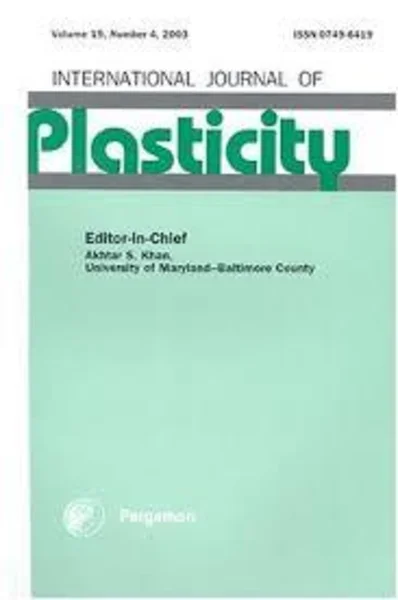-
ductile fracture: experiments and computations
جزئیات بیشتر مقاله- تاریخ ارائه: 1390/01/01
- تاریخ انتشار در تی پی بین: 1390/01/01
- تعداد بازدید: 825
- تعداد پرسش و پاسخ ها: 0
- شماره تماس دبیرخانه رویداد: -
numerous criteria have been developed for ductile fracture (df) prediction in metal plastic deformation. finding a way to select these df criteria (dfcs) and identify their applicability and reliability, however, is a non-trivial issue that still needs to be addressed in greater depth. in this study, several criteria under the categories of ‘uncoupled damage criterion’ and the ‘coupled damage criterion’, including the continuum damage mechanics (cdm)-based lemaitre model and the gurson–tvergaard–needleman (gtn) model, are investigated to determine their reliability in ductile failure prediction. to create diverse stress and strain states and fracture modes, different deformation scenarios are generated using tensile and compression tests of al-alloy 6061 (t6) with different sample geometries and dimensions. the two categories of criteria are coded into finite element (fe) models based on the unconditional stress integration algorithm in the vumat/abaqus platform. through physical experiments, computations and three industrial case studies, the entire correlation panorama of the dfcs, deformation modes and df mechanisms is established and articulated. the experimental and simulation results show the following. (1) the mixed df mode exists in every deformation of concern in this study, even in the tensile test of the round bar sample with the smallest notch radius. a decrease of stress triaxiality (η-value) leads to a reduction in the accuracy of df prediction by the two dfc categories of dfcs, due to the interplay between the principal stress dominant fracture and the shear–stress dominant factor. (2) for deformations with a higher η-value, both categories of dfcs predict the fracture location reasonably well. for those with a lower or even negative η-value, the gtn and cdm-based criteria and some of the uncoupled criteria, including the c&l, ayada and oyane models, provide relatively better predictions. only the tresca and freudenthal models can properly predict the shear dominant fracture. the reliability sequence of fracture moment prediction is thus the gtn model, followed by the cdm-based model and the uncoupled models. (3) the applicability of the dfcs depends on the use of suitable damage evolution rules (void nucleation/growth/coalescence and shear band) and consideration of several influential factors, including pressure stress, stress triaxiality, the lode parameter, and the equivalent plastic strain or shear stress. these parameters determine the deformation mode (shear dominant or maximum principal stress dominant deformation) and, further, the df mechanism (dimple fracture/shear fracture/mixed fracture).
مقالات جدیدترین رویدادها
-
استفاده از تحلیل اهمیت-عملکرد در ارائه الگوی مدیریت خلاقیت سازمانی و ارائه راهکار جهت بهبود
-
بررسی تاثیر ارزش وجوه نقد مازاد بر ساختار سرمایه شرکت های پذیرفته شده در بورس اوراق بهادار تهران
-
بررسی تأثیر سطح افشای ریسک بر قرارداد بدهی شرکت های پذیرفته شده در بورس اوراق بهادار تهران
-
بررسی تأثیر رتبه بندی اعتباری مبتنی بر مدل امتیاز بازار نوظهور بر نقد شوندگی سهام با تأکید بر خصوصی سازی شرکت ها
-
تأثیر آمیخته بازاریابی پوشاک ایرانی بر تصویر ذهنی مشتری پوشاک ایرانی (هاکوپیان)
-
اهمیت استراتژی مدیریت اکوسیستم در منطقه گردشگری دریای عمان
-
بررسی منشا گارنت های موجود در گرانودیوریت های منطقه دهنو، شمال غرب مشهد، استان خراسان رضوی
-
نقش سرمایه فکری در بهبود فرآیندهای اقتصادی
-
مقایسه تأثیر لیزر کم توان و اولتراسوند در مبتلایان به سندرم درد عضلانی- فاشیایی
-
effect of (zn(oh)2)3(znso4)(h2o)5 on the performance of ru–zn catalyst for benzene selective hydrogenation to cyclohexene
مقالات جدیدترین ژورنال ها
-
مدیریت و بررسی افسردگی دانش آموزان دختر مقطع متوسطه دوم در دروان کرونا در شهرستان دزفول
-
مدیریت و بررسی خرد سیاسی در اندیشه ی فردوسی در ادب ایران
-
واکاوی و مدیریت توصیفی قلمدان(جاکلیدی)ضریح در موزه آستان قدس رضوی
-
بررسی تاثیر خلاقیت، دانش و انگیزه کارکنان بر پیشنهادات نوآورانه کارکنان ( مورد مطالعه: هتل های 3 و 4 ستاره استان کرمان)
-
بررسی تاثیر کیفیت سیستم های اطلاعاتی بر تصمیم گیری موفق در شرکتهای تولیدی استان اصفهان (مورد مطالعه: مدیران شرکتهای تولیدی استان اصفهان)
-
مطالعه تاثیر بانکداری الکترونیکی بر نیت رفتاری مصرف کنندگان در صنعت بانکداری
-
بررسی درآمدهای مالیاتی خراسان شمالی و ارتباط بین درآمد مصوب شده و عملکرد از سال 90-96
-
نقش توان مندی مدیران در کشف کلاه برداری گزارشگری مالی با در نظر گرفتن حضور و نفوذ صاحب منصبان دولتی در ارکان اداره شرکت ها با تعیین درجه سیاست دولتی بر اساس شاخص sa
-
surface adsorption of carbon monoxide and hydrogen gases mixed with boron nitride (7 ,7) nanotubes by monte carlo method
-
the effects of employees’ integrity, responsibility, compassion and forgiveness on corporate social responsibility in iranian private sector in east and west of azerbaijan in iran




سوال خود را در مورد این مقاله مطرح نمایید :